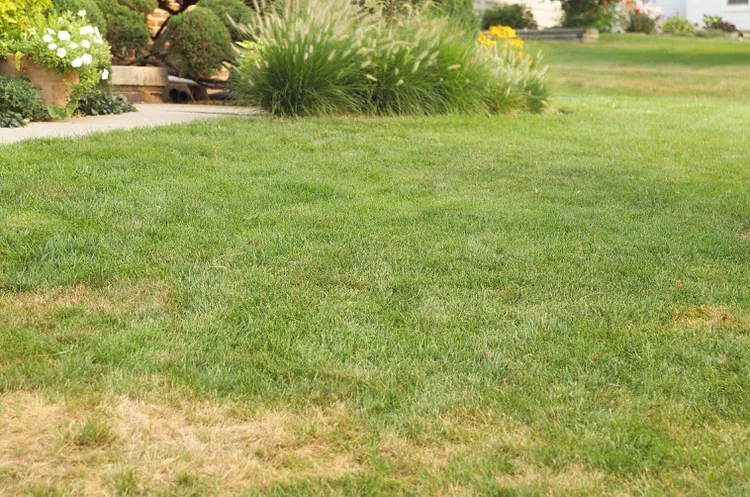Lush, green lawns are such inviting places to play and relax. Come outside, they seem to say. Bring a cold drink and kick back in the hammock. But keeping grass so lush and green often requires fertilizers, pesticides, and water—lots and lots of water. Ready for a shock? A 2005 NASA-led study found that in most U.S. regions, 50 to 75% of a home’s total water usage is for lawn irrigation. This also may surprise you: You probably don’t actually need to water your grass much at all, and you definitely don’t need to triple (or more!) how much you water in summer. Besides helping to conserve water, you can save quite a bit of money and time by avoiding unnecessary lawn irrigation.
Of course, forgoing sprinklers or turning off your irrigation system when the weather turns hot and dry in the summer will usually result in a brown, crispy lawn, but that doesn’t mean your grass is dead or dying.
“Turf grasses can withstand far more drought than we might think,” says Bob Mann, senior director of technical and regulatory affairs with NALP (National Association of Landscape Professionals). “Most grasses are well-adapted to drier conditions. It’s one of their evolutionary benefits,” he adds.
Temperatures also affect grass. Some species grow better in cool seasons and some in warm seasons. Fescue, for example, is a cool season grass that grows best in spring and fall, when temperatures are lower. Grasses like Bermuda and Zoysia are warm season grasses that tolerate more heat. In the northern U.S., Mann says cool-season grasses grow more slowly when the temperatures rise. This is referred to as heat stress. Warm season grasses in the south do the opposite: Their growth increases as the temperatures rise.
Why Your Grass Might Be Turning Brown in Summer
Grass can turn brown and go dormant when it’s stressed by drought, heat, or both. It’s your lawn’s way of conserving energy and water, Mann explains. The grass will break dormancy and begin growing again when the temperatures and/or rainfall levels become more ideal for it. Note that when dormancy ends, grass leaves that have turned brown won’t revive, but new leaves will appear.
What to Do When Your Grass Starts Turning Brown
If your grass is turning brown—in other words, your lawn is dormant, or going dormant, try not to worry.
”Try to let Mother Nature do her thing,“ says Mann. Rain often provides enough moisture to keep your grass alive while dormant, but in a severe drought, without any rainfall for more than four weeks, ”a quick watering of1/4 inch or so should be sufficient,“ he adds.
This little bit of water can prevent your grass from reaching a point of no return when it can’t recover. If you’re worried that your grass might be dead rather than dormant, Mann suggests pulling up a single grass plant and peeling back the individual leaves, like you’d shuck an ear of corn. Green tissue in the middle means the grass is still alive. “If you aren’t sure, ask a landscape or lawn professional for help,” he says.
What If Your Neighbors Say Something About Your Grass Turning Brown?
If you belong to a homeowners association that mandates a carefully maintained lawn, talk to your fellow members.
“Education is key to getting buy-in from HOAs,” Mann says. “Everyone needs to understand that in times of drought, it’s okay for lawns to turn brown, and in most cases the grass will bounce back when rain returns.”
Bob Mann, National Association of Landscape Professionals
Everyone needs to understand that in times of drought, it's okay for lawns to turn brown, and in most cases the grass will bounce back when rain returns.
More Benefits of Letting Your Grass Turn Brown in Summer
Besides saving water, money, and time, letting your lawn go dormant in the summer has another advantage, Mann points out: You can stop mowing. If you do mow, you may wind up with conspicuous tire tracks, but they’ll eventually go away.
Brandy Hall, founder and managing director of Atlanta-based Shades of Green Permaculture says you can cut back on watering not only when grass is dormant, but also at other times by creating a more resilient lawn. She recommends choosing the best grass species for your region’s climate and “growing diverse, broadleaf species” like Dutch white clover in with the grasses. Increasing the amount of organic matter in your soil to improve its ability to hold moisture also can help.
“Beware of silver bullets,” Hall adds. “No plant is the perfect grass that never needs mowing, never needs water, and all of those things. Understand that living species have different growth habits and needs for sun and moisture. Learn to work with those, just like you’d work with your hydrangeas. Research your soil and lawn species and get advice from ecological design or permaculture companies.”
“You can have your yard and eat it, too,” she says with a laugh. “It’s absolutely possible to have a beautiful green lawn. It just requires loosening your perception of what a beautiful lawn is.”




















